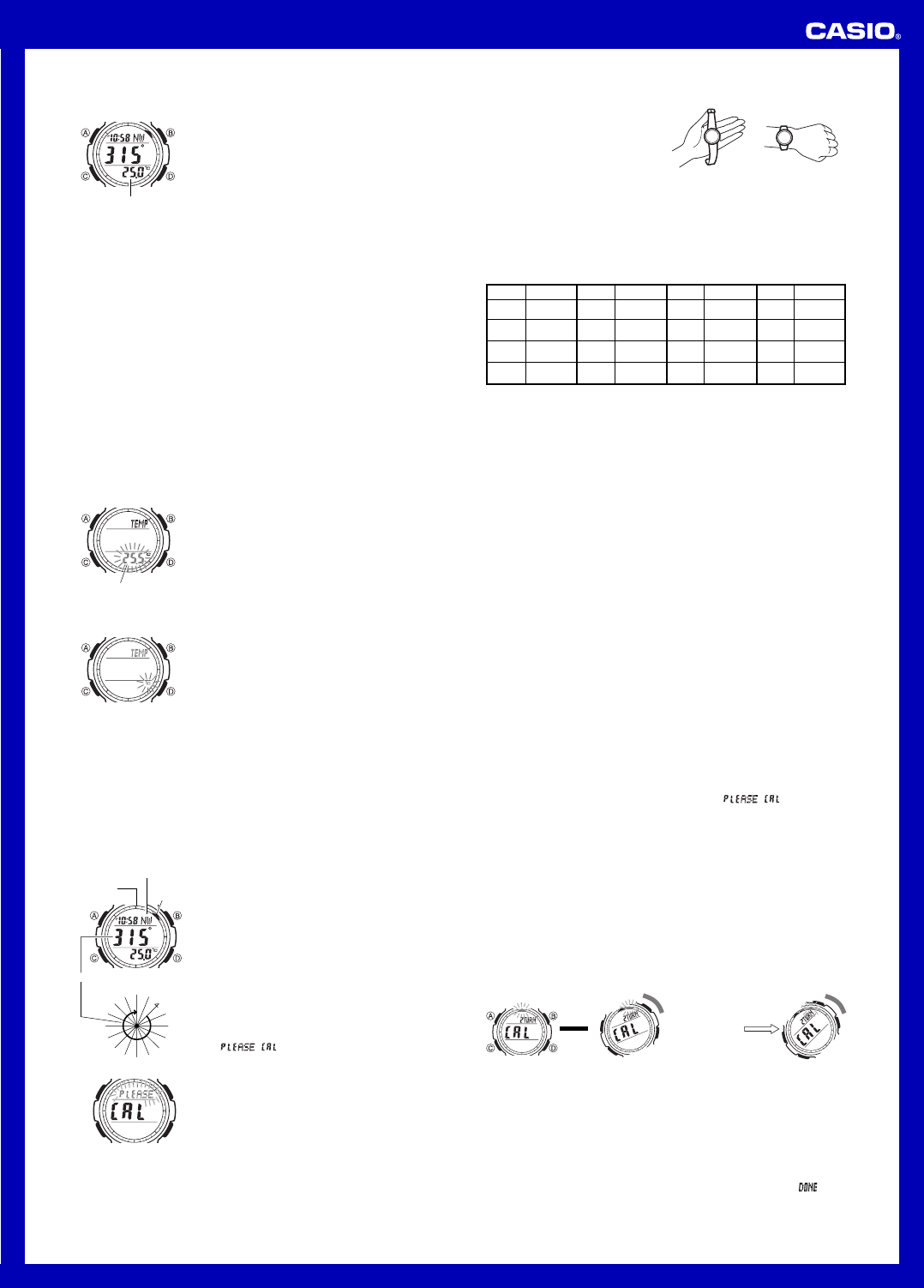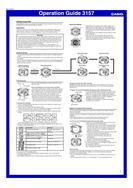
Operation Guide 3157
2
To take a temperature reading
In the Digital Compass/Thermometer Mode, press D.
• This will display the temperature reading.
• After the first reading, the watch will continue to take
readings every two seconds for about 10 seconds.
• After the temperature reading is complete, the
temperature display will show “- -. -”.
• To perform temperature readings for another 10
seconds, press D again.
• The temperature is displayed in units of 0.1°C (or 0.2°F).
• The display range of the thermometer screen is –10.0°C
to 60.0°C (or 14.0°F to 140.0°F). The temperature
display will show xxx if a temperature reading is
outside the allowable range.
Temperature
Important!
• Sudden temperature changes can affect pressure sensor readings.
• Temperature measurements are affected by your body temperature (while you are
wearing the watch), direct sunlight, and moisture. To achieve a more accurate
temperature measurement, remove the watch from your wrist, place it in a well
ventilated location out of direct sunlight, and wipe all moisture from the case. It takes
approximately 20 to 30 minutes for the case of the watch to reach the actual
surrounding temperature.
Temperature Sensor Calibration
The temperature sensor built into the watch is calibrated at the factory, and normally
does not need any adjustment. However, if you feel that readings being produced by
the watch are not correct for some reason, you can calibrate the temperature sensor
to correct them.
Important!
• Incorrectly calibrating the temperature sensor can result in incorrect readings.
Carefully read the following before doing anything.
Compare the readings produced by the watch with those of another reliable and
accurate thermometer.
If adjustment is required, remove the watch from your wrist and wait for 20 or 30
minutes to give the temperature of the watch time to stabilize.
To calibrate the temperature sensor
1. In the Digital Compass/Thermometer Mode, hold down
A until the indicator at the 12 o’clock position starts to
flash.
2. Press C twice and the current temperature calibration
value will flash on the display. This is the temperature
sensor calibration screen.
3. Use D (+) and B (–) to change the calibration value.
• To return the temperature sensor to its factory default
calibration (indicated by OFF on the display), press
D and B at the same time.
4. To exit the calibration screen, press A.
Current temperature
calibration value
To specify the temperature display unit
1.Enter the Timekeeping Mode.
2.Hold down A until the city code starts to flash, which
indicates the setting screen.
3.Press C nine times until the temperature display unit
flashes on the display.
• See step 3 under “To set the time and date” for
information about how to scroll through setting
screens.
4. Use D to switch between Celsius (°C) and Fahrenheit (°F).
5. Press A to exit the setting screen.
l
l
l
l
l
l
l
l
l
l
l
l
l
l
l
l
Digital Compass
The watch takes digital compass readings automatically whenever you enter the
Digital Compass/Thermometer Mode. In addition, you can take readings manually by
performing the procedure below.
• See “Digital Compass Precautions” for important information about using the digital
compass.
• You can calibrate the direction bearing if you think readings are wrong for some
reason.
• For a digital compass practical example, see “Using the Digital Compass While
Mountain Climbing or Hiking”.
To take a direction reading
1.While the watch is in the Digital Compass/Thermometer
Mode, place it on a flat surface, or if you are wearing
the watch, make sure that your wrist is horizontal (in
relation to the horizon).
2.Point the 12 o’clock position of the watch in the
direction you want to measure.
3.Press D to start a Digital Compass measurement
operation.
• After about two seconds, the direction that the 12
o’clock position of the watch is pointing appears on the
display.
• A pointer on the display indicates magnetic north.
• After the first reading is obtained, the watch continues to
take direction readings automatically each second, for
up to 10 seconds.
• To perform direction readings for another 10 seconds,
press D again.
Direction indicator
North
pointer
12 o’clock
position
Angle value (in degrees)
NW
0°
W
N
W
W
W
S
W
SW
SS
W
S
SSE
SE
E
S
E
E
E
N
E
NE
NNE
N
NNW
90°
180°
270°
• The
appearing on the display after a
direction reading is complete indicates that bearing
sensor calibration is required due to either of the
reasons described below. When this happens, perform
the procedure under “Calibrating the Bearing Sensor”.
• It’s been 100 days since the last bearing sensor
calibration.
• The watch’s battery was replaced.
• While the watch is taking compass readings, it displays
a direction angle and a direction indicator, all of which
change dynamically when the watch is moved. After the
compass operation is complete, the direction pointer
disappears from the display, and the direction angle and
direction indicator both show “- - -”. Use the direction
indicators imprinted on the bezel to record the indicated
direction. For details, see “Using the Digital Compass
While Mountain Climbing or Hiking”.
Note
• Note that taking a measurement
while the watch is not horizontal
(in relation to the horizon) can
result in large measurement error.
• The margin of error for the angle value and the direction indicator is ±11 degrees. If
the indicated direction is northwest (NW) and 315 degrees, for example, the actual
direction can be anywhere from 304 to 326 degrees.
• Any ongoing direction measurement operation is paused temporarily while the watch
is performing an alert operation (daily alarm, Hourly Time Signal, countdown timer
alarm) or while illumination is turned on (by pressing B). The measurement
operation resumes for its remaining duration after the operation that caused it to
pause is finished.
• The following table shows the meanings of each of the direction abbreviations that
appear on the display.
• See “Digital Compass Precautions” for other important information about taking
direction readings.
Direction
Meaning
Direction
Meaning
Direction
Meaning
Direction
Meaning
NNE
ESE
SSW
WNW
NE
SE
SW
NW
North-
northeast
East-
southeast
South-
southwest
West-
northwest
Northeast
Southeast
Southwest
Northwest
East-
northeast
South-
southeast
West-
southwest
North-
northwest
ENE
SSE
WSW
NNW
North
East
South
West
N
E
S
W
Digital Compass Precautions
This watch features a built-in magnetic bearing sensor that detects terrestrial
magnetism. This means that north indicated by this watch is magnetic north, which is
somewhat different from true polar north. The magnetic north pole is located in
northern Canada, while the magnetic south pole is in southern Australia. Note that the
difference between magnetic north and true north as measured with all magnetic
compasses tends to be greater as one gets closer to either of the magnetic poles. You
also should remember that some maps indicate true north (instead of magnetic north),
and so you should make allowances when using such maps with this watch.
Location
• Taking a direction reading when you are near a source of strong magnetism can
cause large errors in readings. Because of this, you should avoid taking direction
readings while in the vicinity of the following types of objects: permanent magnets
(magnetic necklaces, etc.), concentrations of metal (metal doors, lockers, etc.), high
tension wires, aerial wires, household appliances (TVs, personal computers,
washing machines, freezers, etc.)
• Accurate direction readings are impossible while in a train, boat, air plane, etc.
• Accurate readings also are impossible indoors, especially inside ferro-concrete
structures. This is because the metal framework of such structures picks up
magnetism from appliances, etc.
Storage
• The precision of the bearing sensor may deteriorate if the watch becomes
magnetized. Because of this, you should be sure to store the watch away from
magnets or any other sources of strong magnetism, including: permanent magnets
(magnetic necklaces, etc.) and household appliances (TVs, personal computers,
washing machines, freezers, etc.)
• Whenever you suspect that the watch may have become magnetized, perform one
of the calibration procedures under “Calibrating the Bearing Sensor”.
Calibrating the Bearing Sensor
If you feel that direction readings being produced by the watch are not correct for
some reason, you can calibrate the bearing sensor to correct them. You can use either
of two methods to calibrate the bearing sensor: bearing sensor correction or magnetic
declination correction.
You also need to calibrate the bearing sensor if 100 days pass without calibration, and
after you have the watch’s battery replaced. The message
will appear on
the display to remind you to calibrate.
• Bearing Sensor Correction
With bearing sensor correction, you rotate the watch in accordance with the
movement of an on-screen indicator. Doing this will recalibrate the magnetic sensor
of the watch with magnetic North for the area where you are located.
• Magnetic Declination Correction
With magnetic declination correction, you input a magnetic declination angle
(difference between magnetic north and true north), which allows the watch to
indicate true north.
You can perform this procedure when the magnetic declination angle is indicated on
the map you are using.
Note that you can input the declination angle in degree units only, so you may need
to round off the value specified on the map. If your map indicates the declination
angle as 7.4°, you should input 7°. In the case of 7.6° input 8°, for 7.5° you can input
7° or 8°.
To calibrate the bearing sensor
Rotate the watch in
accordance with the
movement of the
flashing indicator.
One
second
▲
One
second
1. Remove the watch from your wrist, and position it so its back is parallel with the
ground and the 12 o’clock position is pointed away from you.
2. In the Digital Compass/Thermometer Mode, hold down A until the indicator at the
12 o’clock position starts to flash. This is the calibration screen.
3. Press D.
• The flashing indicator will move clockwise on the face of the watch with each
passing second.
4. Each time the indicator moves, rotate the watch so the indicator remains pointed
away from you.
5. After the flashing indicator completes two full trips around the display (and you
rotate the watch twice), press C.
D
• This completes calibration and exits the calibration screen. The message will
appear on the display for about one second, and then a direction reading operation
will be performed automatically.





















